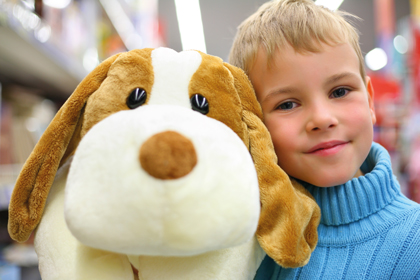Primary Times - the definitive what’s on and where to go family guide of activities and events for children of primary school age. Things to do with your kids during the school holidays including arts and craft activities, music and theatre for children, parties, competitions, days out, and family attractions along with term time drama schools, dance classes, after school clubs and sports activities. Things to do at a place near you!
The Good, The Fad & The Cuddly
 The must-have lists of toys for the year are already being published, and Christmas is looming large on the horizon. Santa is usually pretty switched on and can find most things on the lists of children around the world, but sometimes he needs a little help from ever vigilant parents. Being on the ball and getting out there early to give St Nick a hand is a good idea because every year toy shop workers are driven to mince pie and sherry overload by parents screaming at them on Christmas Eve. It doesn’t matter how hard you shout “WHERE IS MY PO?”, if that mischievous Teletubby is sold out, it’s not going to miraculously appear. Tuning in to what’s popular with your children and their peers is a good way to stay ahead of the curve and often very helpful in not leaving it too late.
The must-have lists of toys for the year are already being published, and Christmas is looming large on the horizon. Santa is usually pretty switched on and can find most things on the lists of children around the world, but sometimes he needs a little help from ever vigilant parents. Being on the ball and getting out there early to give St Nick a hand is a good idea because every year toy shop workers are driven to mince pie and sherry overload by parents screaming at them on Christmas Eve. It doesn’t matter how hard you shout “WHERE IS MY PO?”, if that mischievous Teletubby is sold out, it’s not going to miraculously appear. Tuning in to what’s popular with your children and their peers is a good way to stay ahead of the curve and often very helpful in not leaving it too late.
Fads come and go; this year the Fidget Spinner achieved mass popularity and headlines around the country, but how do toy fads, or fads in general start and is there a difference between memes (the adult version) and the whims of toy fashions?
The sudden appearance of must have toys in the playground is a regular phenomenon and it is something that has occurred on a regular basis long before the internet and social media existed. For example, the simple yo-yo has been enormously popular with various generations and even appeared on The Simpsons as an example of a toy fad explosion - driving poor Edna Krabappel to distraction in the process.
Philip Graves, a Consumer Psychologist and author of Consumer.ology suggests that these explosions in popularity occur when a child sees enough children in a short period of time with a particular toy and this creates a sense of importance around it. If the first children with the toy are also considered to be “cool” and the toy lends itself to being shown or shared, then there’s a good chance of a fad flareup.
It's not just fidget spinning or learning to perfect “Walking The Dog” with your Yo-Yo (with clutch) of course. Collectibles have a way of turning the playground into something that looks like Wall Street. Over the years there’s been playtime racketeering in Pokemon cards, Pogs, McDonald Toys and Panini Stickers. Whether you’ve got to catch them all or need to trade a handful of silvery Club Badge Stickers for the all-important Alan Curtis in his slippers card. “Got – Need – Swap” has long been a mantra heard at breaktimes.
Not knowing what cards you will get until you’ve opened pack; or finding a rare card or toy will generate a peak of excitement when found and when lots of small purchases are required it can create the habit of purchasing them in association with another regular part of daily life. Add this to the hurly burly of the school-yard trading floor, and it’s easy to see how collectibles can become exciting.
With the advent of social media memes are becoming almost as important as toys in the language of the playground and social media. If you don’t know your dab from your grumpy cat, then “How Do You Do Fellow Kids” might be for you.
Memes might be different to fads psychologically, in that they can get into people’s heads and are spread almost unconsciously, but the idea that they are a part of the legacy of people’s reliance on story-telling for passing information through the generations is rather pleasing. Fads and trends tend to be more driven by marketing and the need to fit in, which doesn’t have the same appeal.
Fashions can pass in the blink of an eye. The yo-yo might be gathering dust in a draw but soon it’ll be joined by a spinner as the next big thing takes its place. Making a classic is much harder, but somehow Monopoly, Lego and Barbie (for example) have continued success. Philip Graves suggests that this is down to the manufacturers working hard to constantly make their products relevant to children, which makes sense. Barbie seems to have a new wardrobe, friend and car on a regular basis, but then, she is very popular. Similarly, Lego and Monopoly constantly shift and change to keep parents and children on their toes.
The world is changing though and access to the online world not only makes it harder for fads to take hold (because there are so many distractions and options available) but it is also possible for children to get hugely engaging and rewarding experiences with very little effort on their part which makes for a heady psychological cocktail. Whether this move online will signal the end of the fad in the playground is anyone’s guess, but app developers are certainly designing their products to make them fun and addictive.
Whatever your children ask for this year try not to feel the pressure of getting this year’s big thing and remember that trends come and go. By lunchtime they’ll most likely have spent more time playing with the box.
With thanks to Philip Graves – Consumer Psychologist and author of Consumer.ology
Fads Through The Years
Pet Rock – Parents often hark back to the days when all children needed for entertainment was some string, a stick, and some imagination, but in 1975, all that changed and all they needed was a rock – with some googly eyes on it. Yes, caring for a rock like it was a pet really was all the rage.
Cabbage Patch Dolls – Such was the demand for these dolls in the 80s, that some stores in the US had to hold lotteries for the small supplies they were able to get. In some cases, police had to be called to break up riots of angry parents. Had they deployed Rubik’s Cubes, that would have kept the mobs quiet for a while. Probably.
Furby – The 90s might have been the decade of toy fads beginning with the letter P – Pokemon, Pogs and Polly Pocket, but the Furby won hearts by being furry and cute. If you could find one.
Bratz – When they first appeared, Bratz dolls were not a success, but it wasn’t long before they were challenging Barbie as the most popular doll on the shelves. The subject of multiple controversies since their launch, Bratz dolls are loved and hated in almost equal measure.
Hatchimals – As technology has moved on, the must have items tend to be tablet or console based. All of which seems a bit boring. So, in 2016 when the Hatchimal arrived it seemed a bit more exciting that tech hardware or yet another film tie-in (Star Wars and Frozen, we’re looking at you). It might have seemed to be some kind of weird cross between a Furby and a Tamagotchi, but waiting for a fluffy bird to hatch from an egg? It was pretty adorable.



